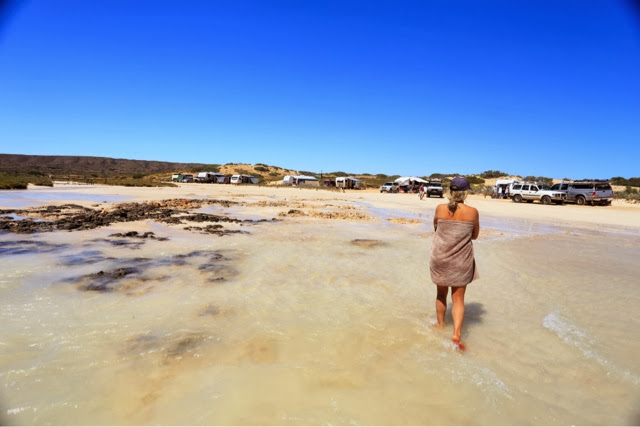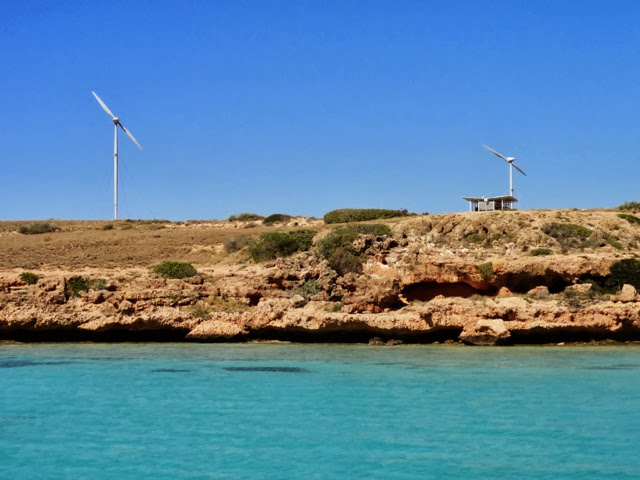Post by Tim
As we made our way south the next part of the WA coast was Exmouth down to Coral Bay following the "Ningaloo Marine Park". We rolled into Exmouth fairly early in the day and a full day ahead of our scheduled arrival date at the near by Cape Range National Park which was a blessing in disguise. As we passed the visitor centre we noticed a large sign out the front saying "Whale Sharks are still here". We were stoked as the normal season had ended a month ago and we though we would miss them. With a full day up our sleeve we booked onto a tour for the following day.

Exmouth Marina.
As it turned out we ended up staying in the northern end of National Park for one night at "Mesa Camp" as it was the cheapest option. We had booked a site at "Osprey Bay" which was around 75km south of Exmouth. The plan was not to have to come back into town once we got down that far.
So the next morning we only had to drive around 15km to board the boat.
We booked through Exmouth Dive Centre who were great!
They gave us a pretty in-depth briefing about what to expect and what the rules were for swimming with the Whale Sharks and after a trial run in the shallow lagoon we headed out into the deep water.

We only travelled about 1-2km from shore, just behind the lagoon and the skipper got the word from the spotter plane that there was a Whale Shark near by. 15 mins later we were in the water swimming beside the biggest fish in the ocean although this one was only around 3.5 metres. What an incredible experience!
Although Whale Sharks may look like whales, they are Sharks, however completely harmless and only eat plankton. Ningaloo reef is one of only a few places in the world where you can have the opportunity to swim with them as they usually spend most of their time 1 to 3km under the surface. They are seen on the surface at Ningaloo for only a few months of the year due to the coral spawning that occurs on the reef. This attracts the plankton which in turn brings the Whale sharks to the surface to feed on the plankton.

They may seem to swim fairly slow, but it was actually pretty hard to keep up with them. Most of the people on board didn't manage to see this one on the first attempt.
Although the sharks can grow up to 15 metres long, the crew said the smaller ones were far more agile and are a much better experience than the larger ones.
We rotated groups in and out of the water and saw two sharks for the morning with a total of around 6 swims. This is by far one of the best experiences ever and everyone should attempt to swim with the Whale Sharks if they get the opportunity.

Posing for a photo. Lol
Many thanks to the crew for their awesome photos. All underwater photos were taken by the guides and were available for free the following day at the office.
After the Whale Shark swims it was Whale time. We saw several on the way in which was a bonus.
The final part of the tour was a snorkel in the lagoon. The visability wasn't real good due to the large swell but we still had fun.


Kristy managed to get a bit sea sick and layed up the front most of the way back in. She also had a couple of spews in the water while swimming with the Whale Sharks. Thanks for the burley! Lol
That afternoon we drove the 75km south to our campsite at "Osprey Bay" which is one of the most southern camping areas in the park. As you drive south you have Cape Range to the left of you and sand dunes / coral lagoon to the right. Awesome drive!
We arrived at Osprey site number 15 which we booked two weeks early. We had met some people back in QLD who had told us that Osprey sites 14,15,16 were the best in the entire National Park. After stopping in at most of the others I completely agree with them. Osprey Bay is the only camping area where the sites are on top of a small cliff over looking the lagoon. Sites 15 and 16 are also right beside the beach with their own tracks leading down to the water.

The track from our site leading down the one of the two small beaches. This is the northern end of the bay and the entire southern end is all sand.
Perfect spot to enter the water (above). The dark section right in front of the beach was also the best snorkelling in the entire bay. We saw several turtles, rays, small white tip reef sharks, and tones of fish and coral straight in front of our camp site.
Ningaloo Reef is the worlds largest fringing reef and runs around 300km from North West Cape (Exmouth) to Red Bluff (Quobba Station) in the south.

Looking north to the end of the bay.
One of the many other great spots in the National Park is "Oyster Stacks" which is about 15km north of Osprey Bay.

It may not look like much from above the water but just 5 metres from shore there is amazing reef and a resident school of around 300 large silver fish (not sure of the species). This was probably the pick of the spots for snorkelling other than Osprey Bay.
Another cool spot to camp although you wouldn't want any big waves at high tide.(above and below)
We spent 6 days relaxing on the beach and snorkelling in the lagoon. As there is no water available in the park we were limited on the amount of time we could stay. As it was we were rationed to 8 litres a day for drinking, cooking and washing up. Unfortunately that doesn't leave much left for showering.
A further 15km to the south of Osprey (and the end of the sealed road) is "Yardie Creek" which is the only gorge in the Nationl Park with permanent water and also runs straight out into the lagoon.

We have seen a lot of Gorges in the past 2 months but this one was the first and only one flowing straight into the ocean. The mouth is covered with sand at the moment but at certain times of the year it's open.
As we walked up the gorge and looking west, we could have been anywhere in the middle of the country, until you turn around and see the ocean. Pretty cool!
The view to the top of the gorge. There are several other gorges in the park but we decided to not worry about the others. This one is the best anyway.
Another great thing about this area is the amount of wildlife. It's hard to look at the ocean or the land without seeing either a whale or a kangaroo. This little guy was on top of the gorge and was one of about a dozen we saw over 1km. Great to see!
Although we had a great week at Cape Range, the story wouldn't be complete without mentioning the wind. The first 3 days it blew 20-30 knots from the west and then swung around to the south in the afternoon with about 2 hours of calm late morning. Thankfully the last few days were better but still windy.
We were pretty envious of everyone in the camping area who had caravans and trailers. It was fairly obvious we were the joke of happy hour with our tent. Lol
This is how it looked most of the time and we ended up with two snapped poles and a tear in the top.
This is what too much wind and sun will do to you. Crazy styles and a beaver tan! Lol
So after a great week(apart from the wind) it was time to head south to Coral Bay. We had the choice to go north to Exmouth and then south on the bitumen for a total of 350km or head along the 4WD coastal track following the reef for a total of around 110km. Hmmmm...... Not much of a decision really.
The start of the track crossing Yardie Creek.
Following the track along the coast was definitely one of the most scenic drives of the trip as we passed by numerous perfect sandy bays with a coral lagoon in front.
About 20km south and 10km out of the national park we reached Ningaloo Station. If this isn't the best station in the country I don't know what is. It borders the Ningaloo Marine Park to the west and has some of the best camping spots along the coast between Cape Range and Coral Bay.
Unfortunately we couldn't drive into any of the bays as you need a key to the gate which they give you after you pay. Another thing to keep in mind if you plan to camp on the station is that the homestead is at the southern end of the station (around 30km from memory) from the best camp sites and you need to return the key after you leave so either way you look at it there is a backtrack involved.
As we made our way south we passed through some massive sand dunes.
About 10km to the west of Coral Bay we popped out onto the hard stuff again. I reccomend this drive to anyone with a 4WD. Stunning!
Below is the main street of Coral Bay. The town is basically two caravan parks, a resort with a public bar, and a small shopping arcade with IGA and bakery etc.
We stayed at the Bayview caravan park.
Directly across the road is the beach which is perfect with white sand a coral reef only 50m off the beach.
Coral Bay and the surrounding lagoon has the highest density of coral anywhere in Ningaloo Marine Park.
As planned, the following day, we went out on a dive charter. We had two dives and a snorkel with the Manta Rays. Unfortunately we didn't have an underwater camera this time but both dive sites were great and swimming with the Mantas was another amazing experience.
Coral Bays wind turbines used to generate electricity.
We only spent one full day in Coral Bay but probably would have stayed longer if the parks weren't so expensive. This has capped off the week long Ningaloo section of our trip and what a week it was! Can't wait to come back to this area again one day!



















































































